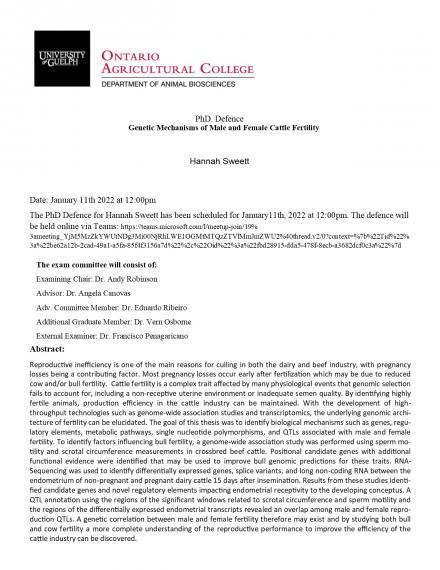Hannah Sweett's PhD Defence
Date and Time
Location
Teams: https://teams.microsoft.com/l/meetup-join/19%3ameeting_YjM5MzZkYWUtNDg3Mi00NjRhLWE1OGMtMTQzZTVlMmJmZWU2%40thread.v2/0?context=%7b%22Tid%22%3a%22be62a12b-2cad-49a1-a5fa-85f4f3156a7d%22%2c%22Oid%22%3a%22fbd28915-dda5-478f-8ecb-a3682dcf0c3a%22%7d

Details
Reproductive inefficiency is one of the main reasons for culling in both the dairy and beef industry, with pregnancy losses being a contributing factor. Most pregnancy losses occur early after fertilization which may be due to reduced cow and/or bull fertility. Cattle fertility is a complex trait affected by many physiological events that genomic selection fails to account for, including a non-receptive uterine environment or inadequate semen quality. By identifying highly fertile animals, production efficiency in the cattle industry can be maintained. With the development of high-throughput technologies such as genome-wide association studies and transcriptomics, the underlying genomic architecture of fertility can be elucidated. The goal of this thesis was to identify biological mechanisms such as genes, regulatory elements, metabolic pathways, single nucleotide polymorphisms, and QTLs associated with male and female fertility. To identify factors influencing bull fertility, a genome-wide association study was performed using sperm motility and scrotal circumference measurements in crossbred beef cattle. Positional candidate genes with additional functional evidence were identified that may be used to improve bull genomic predictions for these traits. RNA-Sequencing was used to identify differentially expressed genes, splice variants, and long non-coding RNA between the endometrium of non-pregnant and pregnant dairy cattle 15 days after insemination. Results from these studies identified candidate genes and novel regulatory elements impacting endometrial receptivity to the developing conceptus. A QTL annotation using the regions of the significant windows related to scrotal circumference and sperm motility and the regions of the differentially expressed endometrial transcripts revealed an overlap among male and female reproduction QTLs. A genetic correlation between male and female fertility therefore may exist and by studying both bull and cow fertility a more complete understanding of the reproductive performance to improve the efficiency of the cattle industry can be discovered.